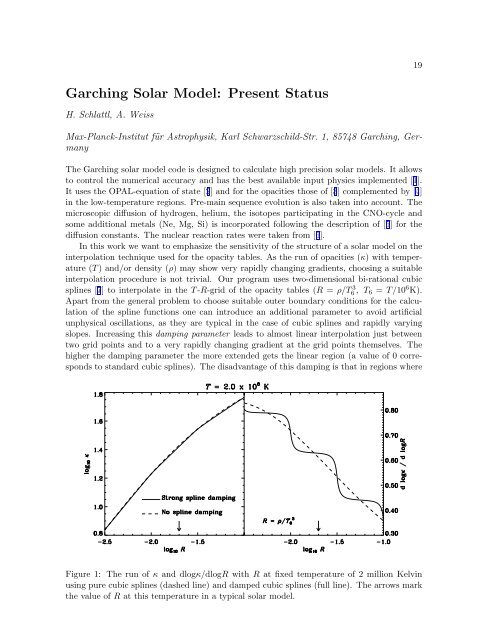Proc. Neutrino Astrophysics - MPP Theory Group
Proc. Neutrino Astrophysics - MPP Theory Group
Proc. Neutrino Astrophysics - MPP Theory Group
Create successful ePaper yourself
Turn your PDF publications into a flip-book with our unique Google optimized e-Paper software.
Garching Solar Model: Present Status<br />
H. Schlattl, A. Weiss<br />
Max-Planck-Institut für Astrophysik, Karl Schwarzschild-Str. 1, 85748 Garching, Germany<br />
The Garching solar model code is designed to calculate high precision solar models. It allows<br />
to control the numerical accuracy and has the best available input physics implemented [1].<br />
It uses the OPAL-equation of state [2] and for the opacities those of [3] complemented by [4]<br />
in the low-temperature regions. Pre-main sequence evolution is also taken into account. The<br />
microscopic diffusion of hydrogen, helium, the isotopes participating in the CNO-cycle and<br />
some additional metals (Ne, Mg, Si) is incorporated following the description of [5] for the<br />
diffusion constants. The nuclear reaction rates were taken from [6].<br />
In this work we want to emphasize the sensitivity of the structure of a solar model on the<br />
interpolation technique used for the opacity tables. As the run of opacities (κ) with temperature<br />
(T) and/or density (ρ) may show very rapidly changing gradients, choosing a suitable<br />
interpolation procedure is not trivial. Our program uses two-dimensional bi-rational cubic<br />
splines [7] to interpolate in the T-R-grid of the opacity tables (R = ρ/T 3 6 , T6 = T/10 6 K).<br />
Apart from the general problem to choose suitable outer boundary conditions for the calculation<br />
of the spline functions one can introduce an additional parameter to avoid artificial<br />
unphysical oscillations, as they are typical in the case of cubic splines and rapidly varying<br />
slopes. Increasing this damping parameter leads to almost linear interpolation just between<br />
two grid points and to a very rapidly changing gradient at the grid points themselves. The<br />
higher the damping parameter the more extended gets the linear region (a value of 0 corresponds<br />
to standard cubic splines). The disadvantage of this damping is that in regions where<br />
Figure 1: The run of κ and dlogκ/dlogR with R at fixed temperature of 2 million Kelvin<br />
using pure cubic splines (dashed line) and damped cubic splines (full line). The arrows mark<br />
the value of R at this temperature in a typical solar model.<br />
19













